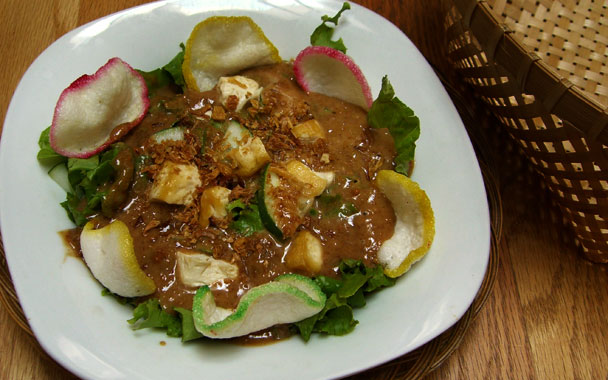Hailing from Indonesia, gado-gado is the better-tasting ancestor of every salad with “Asian peanut dressing.” The dressing is fiery and not too sweet, and because it’s made from freshly roasted and ground peanuts rather than peanut butter, it retains some textural interest. In short, it’s the perfect summer salad: raw and refreshing but substantial enough to be a main dish, which is how it’s generally enjoyed on its home turf in Java.
You can find an excellent gado-gado recipe in James Oseland’s book Cradle of Flavor. As I read the book, however, I became increasingly jealous of the author and his generous friends, who ply him with spicy delights as he makes his way through Indonesia. Two can play at this game, Oseland! So I went to visit a real Indonesian grandmother, Julia Suparman, owner of Julia’s Indonesian Kitchen in Seattle.
“Gado-gado” means “mixed,” explains Suparman. It can be made with raw or cooked vegetables, or a combination of the two. At Julia’s, Suparman uses mostly raw ingredients, which is the Jakarta style, but throws in some cooked Yukon Gold potato, fried tofu, and a sliced hard-boiled egg. As for the dressing, “It’s pure peanut,” Suparman says: fried whole peanuts ground with garlic, lime juice, palm sugar...and a secret ingredient. “I use water from boiling kaffir lime leaf” to thin the dressing, she reveals. Because she sells gado-gado as a vegetarian dish, she doesn’t put belacan (shrimp paste) in the dressing, and because not everyone likes it hot, she stirs in spicy sambal at the customer’s request.
The garnishes are as important to gado-gado as the vegetables and peanut sauce. Suparman sprinkles her salad with crispy fried shallots and garlic and arranges krupuk around the edge of the bowl. Krupuk are fried crackers; the most well-known are shrimp chips, but other flavors include onion, fish, and melinjo nut. As if gado-gado wasn’t already packed with flavor and texture, as you eat it, you break off bits of the assorted crackers and add them to each mouthful.
Unfried krupuk, which are best eaten within a day or two of frying, are available in Asian groceries. Freshly fried, krupuk remind me of Indian pappadams or the bubbly crust of long-fermented sourdough bread.
By the time I finished my gado-gado, I was ready to ask Suparman to be my grandmother. I headed home and perused Cradle of Flavor. I found no mention of kaffir lime leaf water. You hear that, Oseland?


